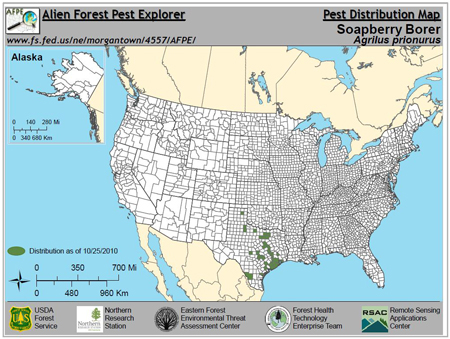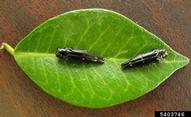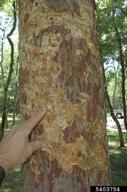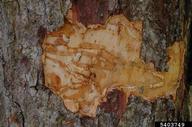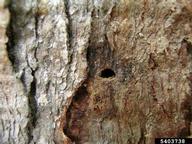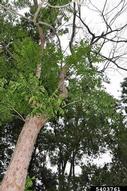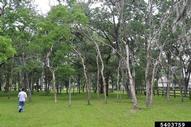Soapberry borer
Agrilus prionurus Chevrolat (Coleoptera: Buprestidae)
Orientation to pest
The soapberry borer, Agrilus prionurus Chevrolat, is a Mexican wood-boring buprestid about which very little is known. It has moved out of its native range in Mexico into Texas, where it is now killing western soapberry trees (Sapindus saponaria var. drummondii (Hook. and Arn.) L.D. Benson). How it got to Texas is not known, but movement of firewood is a likely explanation. The biology of the insect is not well known but is likely very similar to other invasive Agrilus (e.g., goldspotted oak borer [Agrilus auroguttatus Schaeffer] and emerald ash borer [Agrilus planipennis Fairmaire]). The adults are about 1.3 cm long, black, with four distinctive white dots on the wing covers. The larvae feed immediately under the bark. While not certain, it is likely that the insect has one generation per year, with adults emerging between May and August. The insect probably overwinters as a mature larva or pupa in a cell in the wood of the soapberry trees, with adult beetles later emerging through a "D"-shaped exit hole and laying their eggs on the tree trunk.
Hosts commonly attacked
The only reported host in Texas is western soapberry (S. saponaria var. drummondii). Western soapberry trees larger than 5 cm in diameter at breast height are susceptible and infestation usually results in tree death within 1 to 3 years following initial attack. Hosts in Mexico have not been recorded.
Distribution
Native to Mexico, within the United States this species is currently found only in Texas in 42 counties.
| Figure 1. U.S. distribution of soapberry borer |
Images of soapberry borer
| Figure 2. Adults of soapberry borer, Agrilus prionurus | Figure 3. Damage on the trunk (left) of a western soapberry tree from soapberry borer is highly visible, appearing as scaled patches where birds have picked off the bark on in search of larvae, exposing galleries; larva visible in photo on right | |
| Figure 4. Emergence hole of the soapberry borer, showing typical "D" shape characteristic of buprestids | Figure 5. Western soapberry tree showing branches killed by the soapberry borer and epicormic sprouts along lower trunk. | Figure 6. Damage to group of western soapberry trees by soapberry borer in Houston, Texas |
Important biological control agents related to this pest species
Natural enemies of western soapberry borer are unknown.
Web links for information on soapberry borer
- Texas Invasives Site | Texas invasive plant and pest council
Provides descriptions of insects and questionnaires to report new infestations - Recognition Publication | El Paso Naturally
Includes photos of western soapberry borer - Recognition Publication | Texas Forest Service, Texas A&M University System
Articles
- Wellso, S. G. and J. A. Jackman. 2006. A new species of Anthaxia (Haplanthaxia) Reitter (Coleoptera: Buprestidae) and new North American buprestid distributional and host records. Pan-Pacific Entomologist 82(2): 262-268. (first record in the USA)
- Billings, R. F. and H. A. Pase, III. 2010. Soapberry borer continues to spread in Texas. Texas Forestry, February issue, 7 pp.
